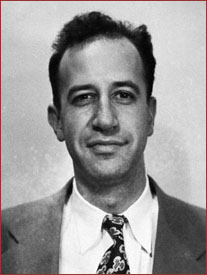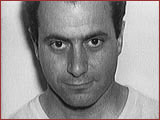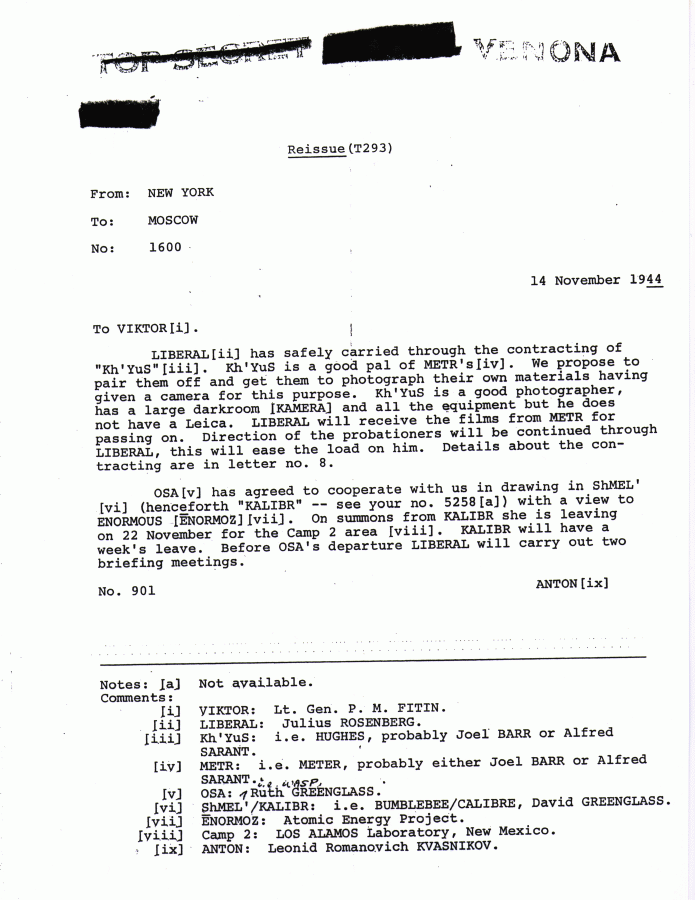 |
 |
|
Read Venona Intercepts
The November 14, 1944 cable:
Joel Barr and Alfred Sarant
Back to Intro
While the Rosenbergs were put to death, two other members of Julius' network
got clean away. This cable chronicles Julius' recruitment of one of them,
Kh'Yus ("Hughes"), who has been identified as Alfred Sarant. The cable
also mentions that Hughes was a good friend of Metr ("Meter"), who was
Joel Barr. Together, the pair effected two of the most successful disappearing acts in espionage history.
Barr and Sarant had much in common. They were staunch Communists whom Julius
Rosenberg recruited to spy for the Soviets. They were good friends and even
shared an apartment at one point during their espionage years. And they were
both electrical engineers who, during the war, worked on military radar at the
U.S. Army Signal Corps laboratories at Fort Monmouth, New Jersey. When they
lost their jobs at the Signal Corps—Barr because Army counterintelligence
uncovered evidence of his Communist leanings, Sarant because of his union
activities—both joined Western Electric and worked on radar
technologies.
 Joel Barr in 1946, four years before he
disappeared.
Joel Barr in 1946, four years before he
disappeared.
|
|
The pair's spying was productive. In another cable, the New York office of the
KGB declared that Hughes had just "handed over 17 authentic drawings related to
the APQ-17." The APQ-17 was a sophisticated airborne radar system that Western
Electric and MIT jointly developed for the U.S. military. After the war ended,
the pair founded a company, Sarant Laboratories, but it was not a success, and
the two went their separate ways, each working in various other jobs throughout
the rest of the 1940s.
The cascade of arrests that followed Klaus Fuchs' confession in early 1950
nearly engulfed Barr and Sarant. Soon after Harry Gold was arrested in May
1950, and a month later David Greenglass, Barr, who was then living in Paris,
vanished without a trace. He left his belongings behind and informed no one of
his departure.
On July 19th, two days after the FBI arrested Julius Rosenberg, they
interviewed Sarant. Not having enough evidence to arrest him, they nevertheless
told him to inform them of any travel plans. He did so: On July
25th, he told them he was driving to Long Island, New York, to spend
a week with relatives. Instead, he hooked up with his mistress and drove to
Mexico, where they, too, vanished without a trace. Both had left behind spouses
and children.
|  Alfred Sarant, before he became the Soviet
scientist Philip Georgievich Staros.
Alfred Sarant, before he became the Soviet
scientist Philip Georgievich Staros.
|
Nothing more was heard from Barr and Sarant for over three decades. Then, in
1983, a Russian researcher at Harvard linked Barr and Sarant to two leading
Soviet scientists, both of whom were native English speakers. Joseph Berg
claimed to be South African, while Philip Georgievich Staros held he was of
Canadian descent. As it turns out, Barr and Sarant had ultimately reached
Czechoslovakia, where the Soviets had set them up as Berg and Staros,
respectively. The Russians eventually moved them to Leningrad, where they
became top researchers in a military electronics research institute and
reportedly launched the Soviet microelectronics industry.
Sarant/Staros died of a heart attack in the USSR in 1979. Barr/Berg returned to
the United States in 1992, denying all participation in espionage, despite
incriminating evidence to the contrary. He died in St. Petersburg, Russia, in
1998.
Note that this cable also documents the successful recruitment of Ruth
Greenglass.
The November 14, 1944 cable
Note: Consult the footnotes at the end of the cable for identities of individuals and definitions of terms appearing in capital letters.
|
|

|
|
Photo credits
Read Venona Intercepts |
Family of Spies
20th-Century Deceptions |
Decipher a Coded Message
Resources |
Transcript |
Teacher's Guide |
Site Map
Secrets, Lies, and Atomic Spies Home
Search |
Site Map |
Previously Featured |
Schedule |
Feedback |
Teachers |
Shop
Join Us/E-Mail |
About NOVA |
Editor's Picks |
Watch NOVAs online |
To print
PBS Online |
NOVA Online |
WGBH
© | Updated January 2002
|
|
|
|